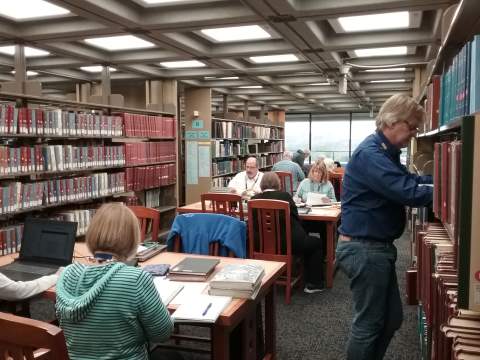It’s on your list—visiting that repository you hope will have the key to answering a longstanding family history mystery. Or, perhaps you have multiple places to visit within a single city or town. The time and cost may be a fair amount, so you will want to make the most of the trip. Here are some tips for a fun and efficient trip.
Focus your trip
It is tempting to try and research as many ancestors as possible during your research trip. Instead of tackling your entire family tree, select a few individuals and/or branches to focus on. When selecting your research topics, consider what records you might need that are specific to the repository and location(s) you are visiting.
Prepare your research questions in advance
Being prepared for your research trip is key. An effective way to prepare is to do a careful review of the information you have about the target individual and her/his family. Review the documents, stories, and images you have collected over time and write a brief summary of what you know about the person. Now is the time to identify specific questions to which you would like answers (these can become your research questions). Spending a short amount of time writing can help synthesize all those thoughts rattling around in your head.
Develop a research plan
While you may need assistance from a librarian, professional genealogist, or archivist, starting to develop your research plan before the trip enables you to maximize your time at a repository. Find research guides for your target area, religion, or ethnicity. For all three subjects for New York State, see the New York Family History Research Guide and Gazetteer. A research plan can include target collections to be searched, specifically books or manuscripts, though be sure to not overlook pamphlets, photographs, typescripts, and other materials.
Search the Online Catalog and collection pages
If you are visiting a library, review the library’s website for their catalog, collection pages, and finding aids (usually created for manuscript collections). Searching for surname(s) and location(s) that are part of your research questions can be helpful. Don’t forget, spellings of places and names change over time. Usie gazetteers to find former and alterative place names (for example, see the Introduction to Part Two of the New York Family History Research Guide and Gazetteer for a listing of period New York gazetteers, as well as the place name index).
Collection pages can be helpful—for example a trip to the New York State Library could include a review of their newspaper page and a visit to the New York Archives’ Military Records page can assist when planning a trip there. These pages can guide you through the collection, and will save you time “on the ground.”
The NYG&B holds several research trips each year, including the autumn Research in Albany, Empire State Exploration (based at the NYG&B offices), and new for 2020, a Salt Lake City research trip.
See our events calendar for details. Heritage tours can combine historical sightseeing with a taste of research. You can also watch our eNews for details of the upcoming heritage tour to Belfast and Northern Ireland.
